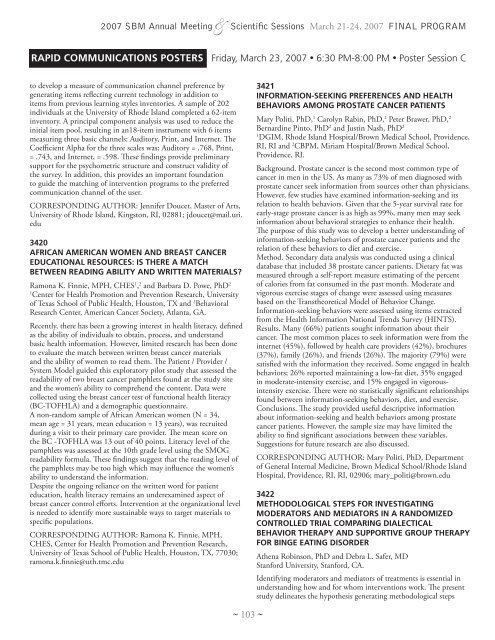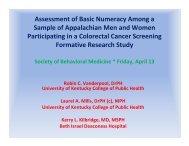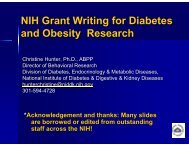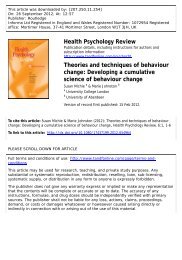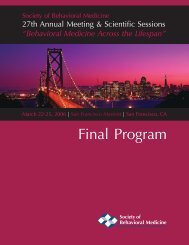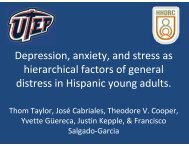2007 Final Program - Society of Behavioral Medicine
2007 Final Program - Society of Behavioral Medicine
2007 Final Program - Society of Behavioral Medicine
You also want an ePaper? Increase the reach of your titles
YUMPU automatically turns print PDFs into web optimized ePapers that Google loves.
<strong>2007</strong> SBM Annual Meeting & Scientific Sessions March 21-24, <strong>2007</strong> FINAL PROGRAM<br />
Rapid Communications Posters Friday, March 23, <strong>2007</strong> • 6:30 PM-8:00 PM • Poster Session C<br />
to develop a measure <strong>of</strong> communication channel preference by<br />
generating items reflecting current technology in addition to<br />
items from previous learning styles inventories. A sample <strong>of</strong> 202<br />
individuals at the University <strong>of</strong> Rhode Island completed a 62-item<br />
inventory. A principal component analysis was used to reduce the<br />
initial item pool, resulting in an18-item instrument with 6 items<br />
measuring three basic channels: Auditory, Print, and Internet. The<br />
Coefficient Alpha for the three scales was: Auditory = .768, Print,<br />
= .743, and Internet, = .598. These findings provide preliminary<br />
support for the psychometric structure and construct validity <strong>of</strong><br />
the survey. In addition, this provides an important foundation<br />
to guide the matching <strong>of</strong> intervention programs to the preferred<br />
communication channel <strong>of</strong> the user.<br />
CORRESPONDING AUTHOR: Jennifer Doucet, Master <strong>of</strong> Arts,<br />
University <strong>of</strong> Rhode Island, Kingston, RI, 02881; jdoucet@mail.uri.<br />
edu<br />
3420<br />
AFRICAN AMERICAN WOMEN AND BREAST CANCER<br />
EDUCATIONAL RESOURCES: IS THERE A MATCH<br />
BETWEEN READING ABILITY AND WRITTEN MATERIALS?<br />
Ramona K. Finnie, MPH, CHES 1 , 2 and Barbara D. Powe, PhD 2<br />
1<br />
Center for Health Promotion and Prevention Research, University<br />
<strong>of</strong> Texas School <strong>of</strong> Public Health, Houston, TX and 2 <strong>Behavioral</strong><br />
Research Center, American Cancer <strong>Society</strong>, Atlanta, GA.<br />
Recently, there has been a growing interest in health literacy, defined<br />
as the ability <strong>of</strong> individuals to obtain, process, and understand<br />
basic health information. However, limited research has been done<br />
to evaluate the match between written breast cancer materials<br />
and the ability <strong>of</strong> women to read them. The Patient / Provider /<br />
System Model guided this exploratory pilot study that assessed the<br />
readability <strong>of</strong> two breast cancer pamphlets found at the study site<br />
and the women’s ability to comprehend the content. Data were<br />
collected using the breast cancer test <strong>of</strong> functional health literacy<br />
(BC-TOFHLA) and a demographic questionnaire.<br />
A non-random sample <strong>of</strong> African American women (N = 34,<br />
mean age = 31 years, mean education = 13 years), was recruited<br />
during a visit to their primary care provider. The mean score on<br />
the BC -TOFHLA was 13 out <strong>of</strong> 40 points. Literacy level <strong>of</strong> the<br />
pamphlets was assessed at the 10th grade level using the SMOG<br />
readability formula. These findings suggest that the reading level <strong>of</strong><br />
the pamphlets may be too high which may influence the women’s<br />
ability to understand the information.<br />
Despite the ongoing reliance on the written word for patient<br />
education, health literacy remains an underexamined aspect <strong>of</strong><br />
breast cancer control efforts. Intervention at the organizational level<br />
is needed to identify more sustainable ways to target materials to<br />
specific populations.<br />
CORRESPONDING AUTHOR: Ramona K. Finnie, MPH,<br />
CHES, Center for Health Promotion and Prevention Research,<br />
University <strong>of</strong> Texas School <strong>of</strong> Public Health, Houston, TX, 77030;<br />
ramona.k.finnie@uth.tmc.edu<br />
3421<br />
INFORMATION-SEEKING PREFERENCES AND HEALTH<br />
BEHAVIORS AMONG PROSTATE CANCER PATIENTS<br />
Mary Politi, PhD, 1 Carolyn Rabin, PhD, 2 Peter Brawer, PhD, 2<br />
Bernardine Pinto, PhD 2 and Justin Nash, PhD 2<br />
1<br />
DGIM, Rhode Island Hospital/Brown Medical School, Providence,<br />
RI, RI and 2 CBPM, Miriam Hospital/Brown Medical School,<br />
Providence, RI.<br />
Background. Prostate cancer is the second most common type <strong>of</strong><br />
cancer in men in the US. As many as 73% <strong>of</strong> men diagnosed with<br />
prostate cancer seek information from sources other than physicians.<br />
However, few studies have examined information-seeking and its<br />
relation to health behaviors. Given that the 5-year survival rate for<br />
early-stage prostate cancer is as high as 99%, many men may seek<br />
information about behavioral strategies to enhance their health.<br />
The purpose <strong>of</strong> this study was to develop a better understanding <strong>of</strong><br />
information-seeking behaviors <strong>of</strong> prostate cancer patients and the<br />
relation <strong>of</strong> these behaviors to diet and exercise.<br />
Method. Secondary data analysis was conducted using a clinical<br />
database that included 38 prostate cancer patients. Dietary fat was<br />
measured through a self-report measure estimating <strong>of</strong> the percent<br />
<strong>of</strong> calories from fat consumed in the past month. Moderate and<br />
vigorous exercise stages <strong>of</strong> change were assessed using measures<br />
based on the Transtheoretical Model <strong>of</strong> Behavior Change.<br />
Information-seeking behaviors were assessed using items extracted<br />
from the Health Information National Trends Survey (HINTS).<br />
Results. Many (66%) patients sought information about their<br />
cancer. The most common places to seek information were from the<br />
internet (45%), followed by health care providers (42%), brochures<br />
(37%), family (26%), and friends (26%). The majority (79%) were<br />
satisfied with the information they received. Some engaged in health<br />
behaviors; 26% reported maintaining a low-fat diet, 35% engaged<br />
in moderate-intensity exercise, and 15% engaged in vigorousintensity<br />
exercise. There were no statistically significant relationships<br />
found between information-seeking behaviors, diet, and exercise.<br />
Conclusions. The study provided useful descriptive information<br />
about information-seeking and health behaviors among prostate<br />
cancer patients. However, the sample size may have limited the<br />
ability to find significant associations between these variables.<br />
Suggestions for future research are also discussed.<br />
CORRESPONDING AUTHOR: Mary Politi, PhD, Department<br />
<strong>of</strong> General Internal <strong>Medicine</strong>, Brown Medical School/Rhode Island<br />
Hospital, Providence, RI, RI, 02906; mary_politi@brown.edu<br />
3422<br />
METHODOLOGICAL STEPS FOR INVESTIGATING<br />
MODERATORS AND MEDIATORS IN A RANDOMIZED<br />
CONTROLLED TRIAL COMPARING DIALECTICAL<br />
BEHAVIOR THERAPY AND SUPPORTIVE GROUP THERAPY<br />
FOR BINGE EATING DISORDER<br />
Athena Robinson, PhD and Debra L. Safer, MD<br />
Stanford University, Stanford, CA.<br />
Identifying moderators and mediators <strong>of</strong> treatments is essential in<br />
understanding how and for whom interventions work. The present<br />
study delineates the hypothesis generating methodological steps<br />
~ 103 ~


